California is home to various water bodies, including rivers, lakes, and ponds. With its diverse landscape and varied ecosystems, California offers plenty of opportunities for outdoor enthusiasts to explore and appreciate nature.
But when identifying the largest pond in California, many people may be unsure where to begin.
This article reveals the largest pond in California, its flora and fauna, and its restoration efforts.

The salt ponds have become vital to the Bay Area’s ecology and economy.
©Wirestock Creators/Shutterstock.com
The Largest Pond in California
The largest pond in California is not a single pond but a collection covering thousands of acres. It’s known as San Francisco Bay Ponds.
San Francisco Bay, one of North America’s largest estuaries, is home to a unique feature known as the salt ponds. Over the past century, these shallow water pools, created by human activity, cover thousands of acres of land around the bay.
Despite their artificial origins, the salt ponds have become vital to the Bay Area’s ecology and economy.
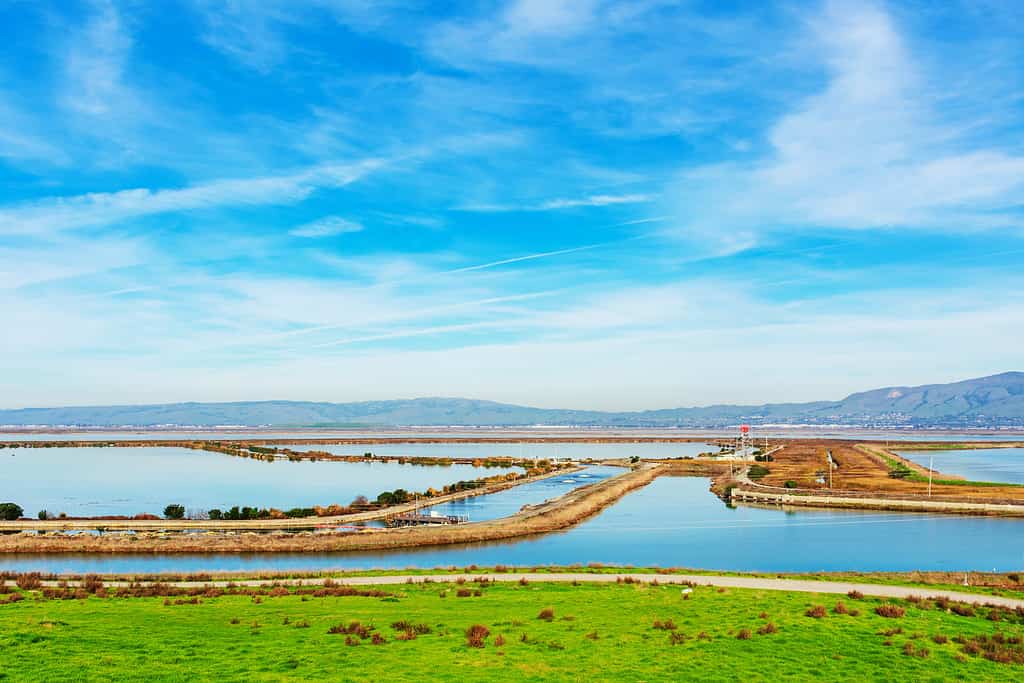
The ponds cover a vast expanse of land around the bay.
©Michael Vi/Shutterstock.com
How Large Are San Francisco Bay Salt Ponds?
The ponds cover a vast expanse of land around the bay.
The salt ponds comprise over 23,000 acres of shallow pools used for salt production and other purposes. To put this into perspective, the salt ponds cover an area larger than the city of San Francisco itself.
Size and Scope
Measuring the size of the salt ponds can be a bit tricky, as the ponds are constantly changing due to the:
- Human activity
- Natural processes
- Weather patterns
But the ponds are typically measured by acreage, each ranging in size from just a few to several hundred acres.
Despite their artificial origins, the ponds have become crucial to the Bay Area’s ecosystem. They provide a habitat for various plant and animal species.
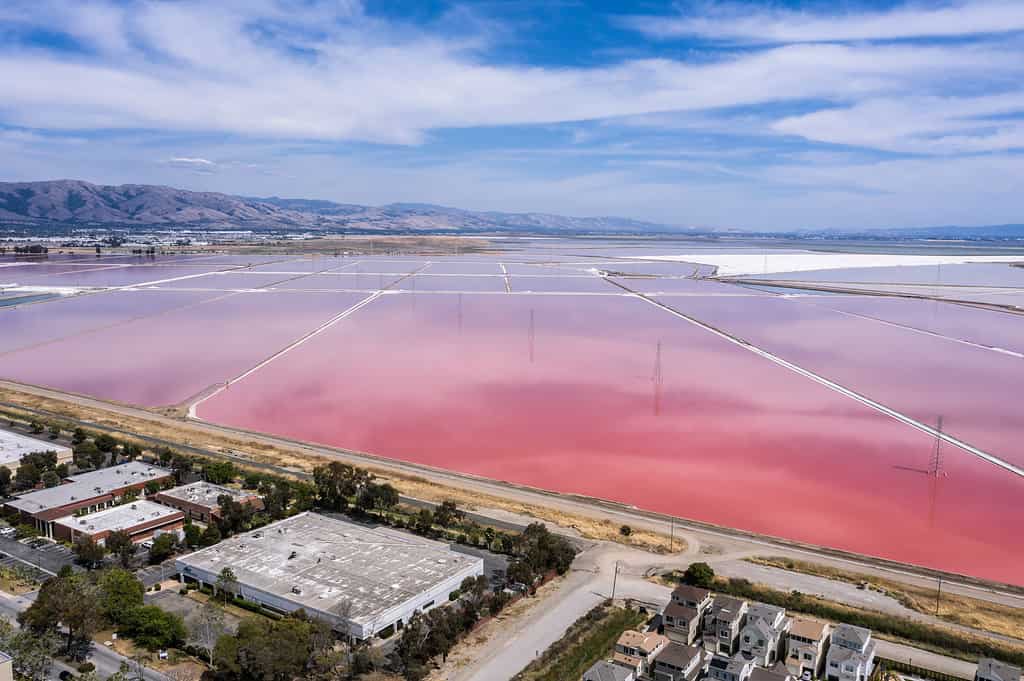
Measuring the size of the salt ponds can be a bit tricky, as the ponds are constantly changing.
©SnapASkyline/Shutterstock.com
How the Ponds Are Measured
The salt ponds are measured using various techniques, including:
- Satellite imagery
- Aerial photography
- On-the-ground surveys
These measurements are used to track changes in the size and shape of the ponds over time and to inform management decisions about the use of the ponds.
Comparison to Other Water Bodies in the Bay Area
Compared to other water bodies in the Bay Area, the salt ponds are relatively shallow.
The average depth of the ponds is only a few feet, with some as shallow as a few inches. This makes the ponds an important habitat for various plant and animal species that require shallow water to survive.
In contrast, other water bodies in the Bay Area, such as the San Francisco Bay itself, can be much deeper, making them less suitable for certain types of aquatic life.
Despite their size and shallow depth, the San Francisco Bay salt ponds play a significant role in the ecology and economy of the Bay Area.
History of the Salt Ponds
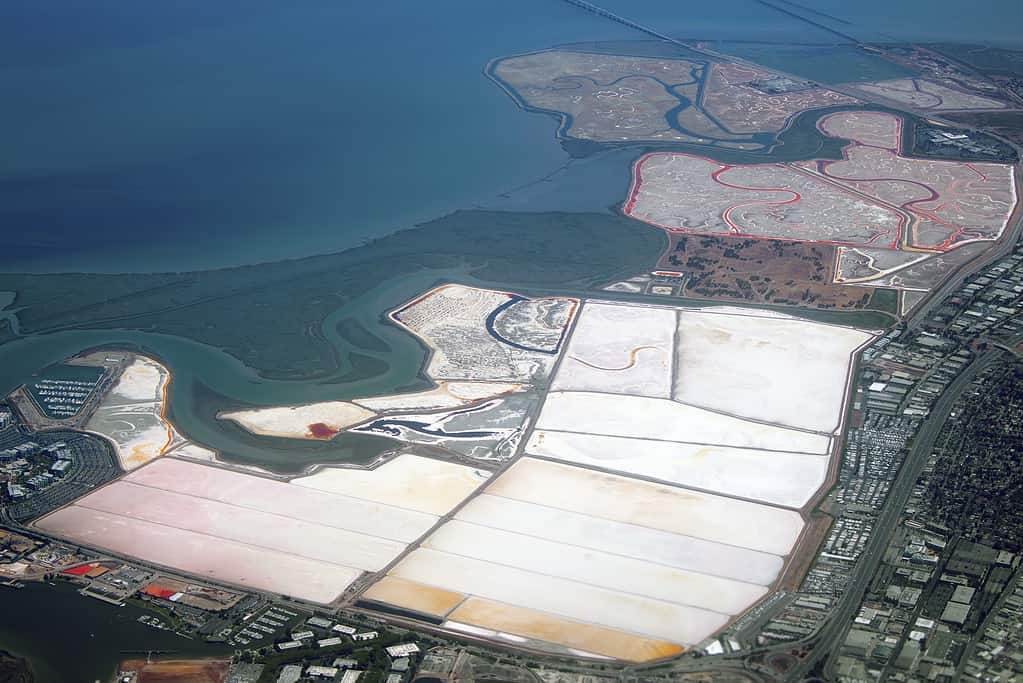
©Natasha Kramskaya/Shutterstock.com
The salt ponds around San Francisco Bay have a long and fascinating history, dating back to the earliest European settlement in the region.
Early Salt Operations
In the mid-1800s, settlers began to harvest salt from the Bay’s salt marshes, which were naturally formed by mixing freshwater and saltwater.
These early salt operations were small-scale and labor-intensive, but they laid the foundation for the larger, more industrialized salt operations that would follow.
Industrialization of Salt Production
By the early 1900s, a handful of companies had begun taking advantage of new salt production technologies and techniques. They included using evaporation ponds to increase efficiency.
These ponds, designed to capture saltwater and allow it to evaporate, were a major innovation that allowed for large-scale salt production in the Bay Area.
Over time, more and more evaporation ponds were constructed, creating the expansive network of salt ponds we see today.
Changes in Salt Production Over Time
As the technology and techniques for salt production continued to evolve, so did the salt ponds’ role in the Bay Area’s economy.
At various times, the salt ponds have been used for a variety of purposes, including:
- As a source of raw materials for chemical production
- As a site for wildlife habitat restoration
Today, salt ponds are primarily used for salt production. But there’s growing interest in their potential as a conservation and recreation site.
Animals in and Around the Ponds
The San Francisco Bay Salt Ponds are a vital habitat for various animals, many of which are adapted to the unique conditions of the saltwater environment.
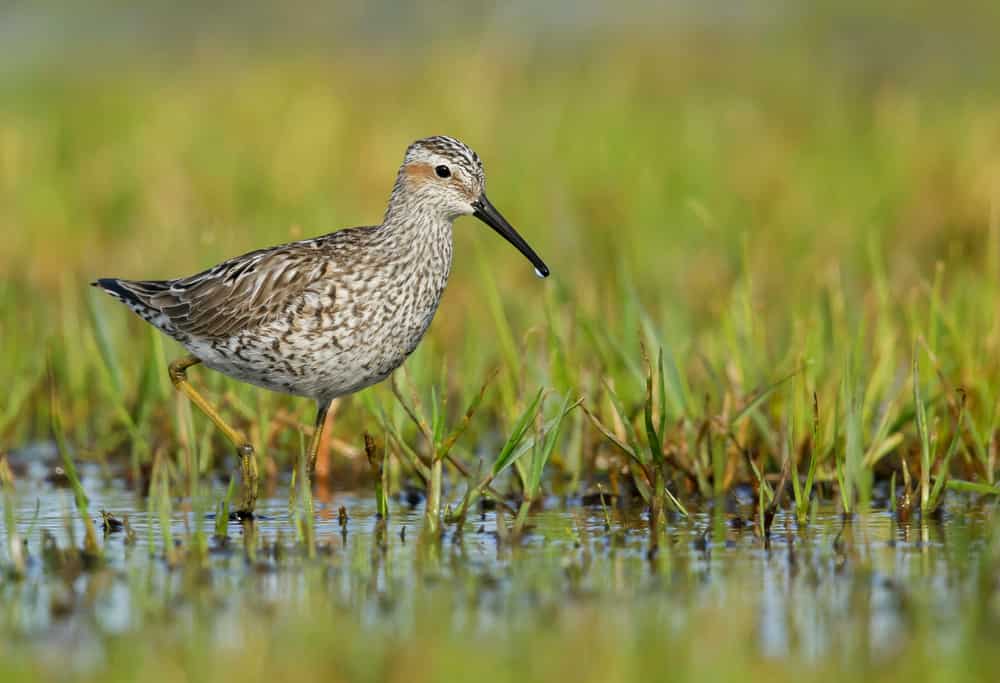
The salt ponds are a crucial stopover site for many migratory bird species, such as the sand piper.
©Agami Photo Agency/Shutterstock.com
Migratory Birds
The salt ponds are a crucial stopover site for many migratory bird species, which rely on them for feeding and resting during their long journeys.
Some of the most common migratory birds that can be seen around the salt ponds include:
- Sandpipers
- Plovers
- Godwits
Waterfowl
In addition to migratory birds, the salt ponds are also an important habitat for various resident waterfowl species, including:
These birds rely on the ponds for food and shelter. They can often be seen swimming and feeding in shallow waters.

Geese can often be seen swimming and feeding in shallow waters.
©Krasula/Shutterstock.com
Harbor Seals
Harbor seals are occasionally spotted in and around the salt ponds, where they come to feed on fish and other prey.
These seals are a charismatic and beloved species. Their presence in the salt ponds is a testament to the diversity of life in this unique ecosystem.

Harbor seals
are occasionally spotted in and around the salt ponds.
©Danita Delimont/Shutterstock.com
Fish and Invertebrates
Several species of fish and invertebrates are in the salt ponds, including:
These species are vital in the ecological balance of salt ponds. Besides, they’re an important food source for many larger animals living in and around the ponds.

Bat rays are vital in the ecological balance of salt ponds.
©Claire Brighten/Shutterstock.com
Plants in and Around the Ponds
The San Francisco Bay Salt Ponds are home to a unique array of plant communities that have adapted to their salty, alkaline soil. They include:
- Salt grasses
- Pickleweed
- Alkali heath
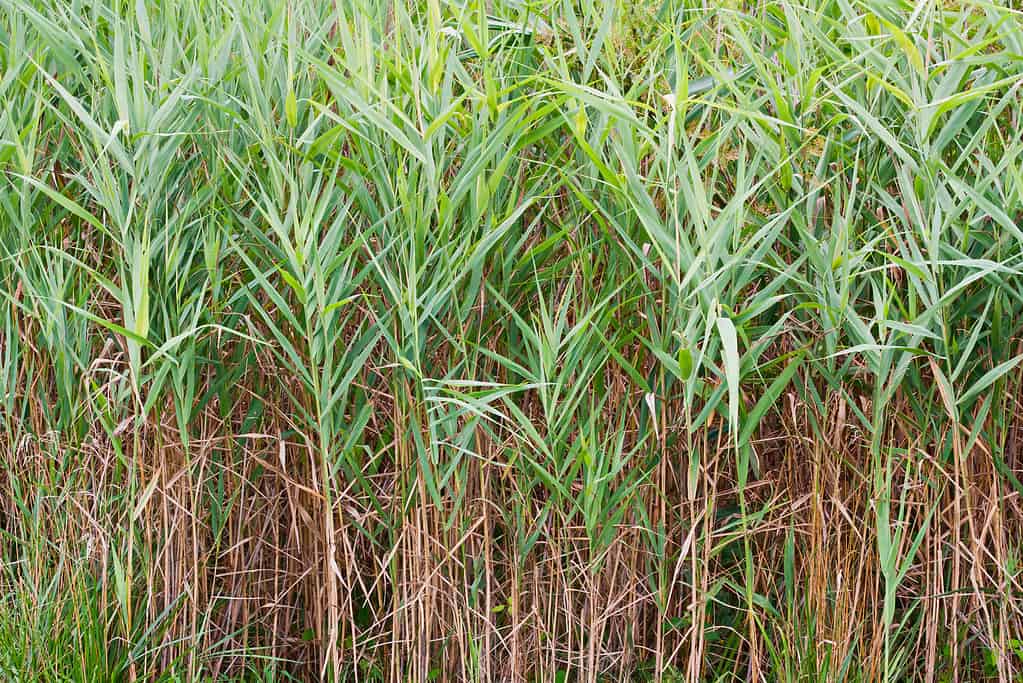
The San Francisco Bay Salt Ponds are home to a unique array of plant communities.
©Stephen Bonk/Shutterstock.com
Salt Grasses
Salt grasses are a common plant community in and around salt ponds.
These grasses have adapted to the salty soil by developing specialized root systems that allow them to absorb water and nutrients in a challenging environment.
Pickleweed
Pickleweed is another common plant in salt ponds. This succulent plant can tolerate the high salt concentrations in the soil by storing water in its leaves.
Alkali Heath
Alkali heath is a rare plant community in salt ponds. These plants have adapted to the high salt concentrations by developing specialized root systems and other adaptations that allow them to survive in this challenging environment.
Restoration Efforts
There has been a growing recognition of the importance of the San Francisco Bay Salt Ponds for both wildlife and human communities.
As a result, significant efforts have been made to restore and protect these unique ecosystems.

There has been a growing recognition of the importance of the San Francisco Bay Salt Ponds for both wildlife and human communities.
©SvetlanaSF/Shutterstock.com
Restoration Projects
Several restoration projects are currently underway in the salt ponds.
These projects include the removal of levees and the reconnection of salt ponds to the bay. This can help improve water quality and provide additional habitat for fish and wildlife.
Public Access
Many restoration projects also include plans to provide public access to the salt ponds, including hiking trails, wildlife viewing platforms, and interpretive exhibits. The aim of these efforts are increasing public awareness and appreciation of salt ponds’ importance for wildlife and human communities.
Partnerships
Partnerships between government agencies, nonprofit organizations, and community groups often lead restoration efforts in the salt ponds.
These partnerships bring together diverse stakeholders with a shared goal of restoring and protecting these unique ecosystems.
Success Stories
There have been many successful restoration projects in the salt ponds, including:
- The restoration of tidal wetlands
- The removal of invasive species
These projects have helped:
- Improve water quality
- Enhance wildlife habitat
- Provide new recreational opportunities for Bay Area residents
Recreation and Education
The San Francisco Bay Salt Ponds offers unique recreational opportunities and provide an excellent environmental education platform.
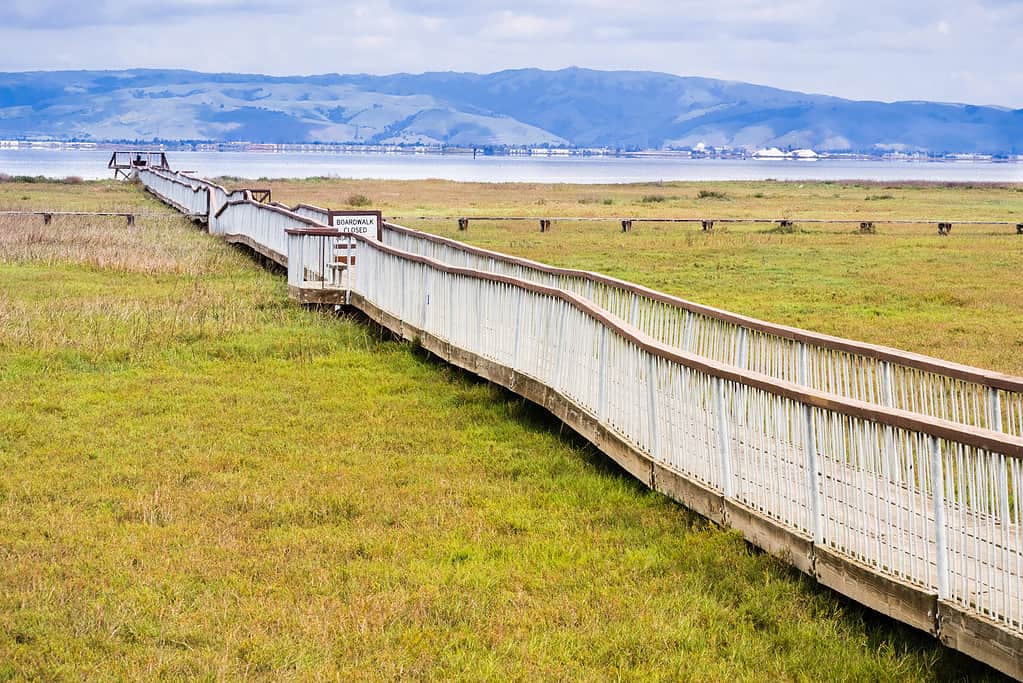
Many restoration projects also include plans to provide public access to the salt ponds.
©Sundry Photography/Shutterstock.com
Recreation
Visitors to the salt ponds can enjoy various recreational activities, including:
- Hiking
- Birdwatching
- Fishing
Several trails have been constructed in and around the salt ponds, providing easy access for hikers and wildlife enthusiasts.
Education
The salt ponds also provide an excellent platform for environmental education.
Many organizations offer educational programs and guided tours of salt ponds. This allows visitors to learn about the ecology and conservation of these unique ecosystems.
Interpretive Centers
Several interpretive centers have been established in and around the salt ponds, providing visitors with interactive exhibits and displays that highlight the importance of the salt ponds for wildlife and human communities.
Citizen Science
Citizen science projects are another way visitors involve themselves in conserving the salt ponds.
These projects allow visitors to participate in data collection and monitoring efforts, helping scientists and conservationists better understand these complex ecosystems.
Benefits of Recreation and Education
Recreation and education in the salt ponds can have numerous benefits, including:
- Increased public awareness and appreciation of the importance of these ecosystems
- Enhanced conservation efforts
- Improved health and well-being for visitors
Future of the Salt Ponds
The future of the San Francisco Bay Salt Ponds is uncertain, but several key factors will be critical in determining the fate of these unique ecosystems. They include:
- Climate change
- Land use changes
- Continued conservation efforts
Climate Change
Climate change is one of the biggest challenges facing salt ponds. Increased storm activity, rising sea levels, and other climate change impacts will likely continue to pressure these fragile ecosystems.
Strategies such as the restoration of wetlands, the removal of invasive species, and the reconnection of salt ponds to the bay can help mitigate some of these impacts.
Land Use Changes
Land use changes, such as new housing or infrastructure development, can also significantly impact the salt ponds.
Strategies such as establishing conservation easements or acquiring key parcels of land can help ensure the long-term protection of these unique ecosystems.
Continued Conservation Efforts
Continued conservation efforts will be critical to the long-term health and well-being of the salt ponds.
These efforts will require the ongoing dedication and investment of government agencies, nonprofits, and community groups, as well as the public’s engagement in conservation and restoration activities.
Despite the many challenges facing the San Francisco Bay Salt Ponds, there is a reason for optimism. The successes of past restoration projects, the dedication of conservation organizations and community groups, and the growing awareness of the importance of these unique ecosystems all provide hope for a sustainable future for salt ponds.
Key Takeaways
The San Francisco Bay Salt Ponds is a unique and important ecosystem. They’re critical habitats for various plant and animal species. They also offer important recreational and educational opportunities for visitors.
While these ecosystems face many challenges, including the impacts of climate change and urban development pressures, there is hope for their long-term protection and restoration.
Through ongoing conservation and restoration efforts, including removing invasive species, re-establishing wetlands, and engaging the public in citizen science and education programs, we can help ensure a sustainable future for the salt ponds.
The photo featured at the top of this post is © FTiare/Shutterstock.com
Thank you for reading! Have some feedback for us? Contact the AZ Animals editorial team.






